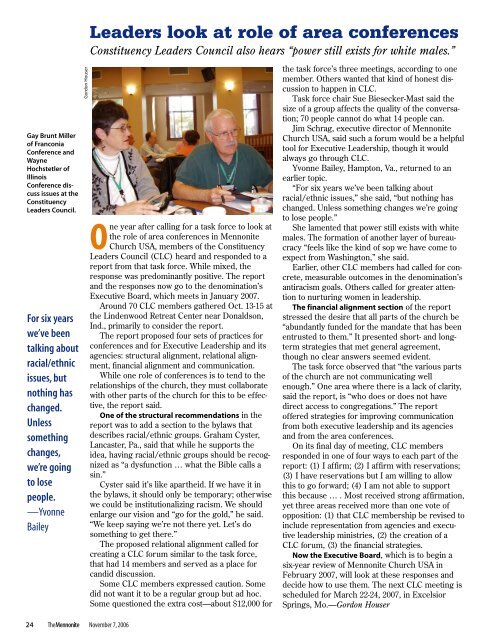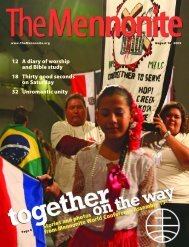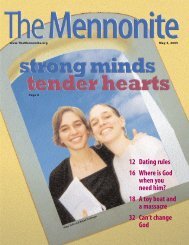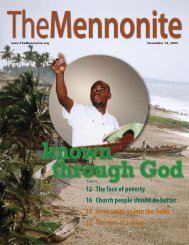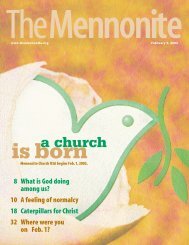11:7,6 - The Mennonite
11:7,6 - The Mennonite
11:7,6 - The Mennonite
Create successful ePaper yourself
Turn your PDF publications into a flip-book with our unique Google optimized e-Paper software.
Gay Brunt Miller<br />
of Franconia<br />
Conference and<br />
Wayne<br />
Hochstetler of<br />
Illinois<br />
Conference discuss<br />
issues at the<br />
Constituency<br />
Leaders Council.<br />
For six years<br />
we’ve been<br />
talking about<br />
racial/ethnic<br />
issues, but<br />
nothing has<br />
changed.<br />
Unless<br />
something<br />
changes,<br />
we’re going<br />
to lose<br />
people.<br />
—Yvonne<br />
Bailey<br />
Gordon Houser<br />
24 <strong>The</strong><strong>Mennonite</strong> November 7, 2006<br />
Leaders look at role of area conferences<br />
Constituency Leaders Council also hears “power still exists for white males.”<br />
One year after calling for a task force to look at<br />
the role of area conferences in <strong>Mennonite</strong><br />
Church USA, members of the Constituency<br />
Leaders Council (CLC) heard and responded to a<br />
report from that task force. While mixed, the<br />
response was predominantly positive. <strong>The</strong> report<br />
and the responses now go to the denomination’s<br />
Executive Board, which meets in January 2007.<br />
Around 70 CLC members gathered Oct. 13-15 at<br />
the Lindenwood Retreat Center near Donaldson,<br />
Ind., primarily to consider the report.<br />
<strong>The</strong> report proposed four sets of practices for<br />
conferences and for Executive Leadership and its<br />
agencies: structural alignment, relational alignment,<br />
financial alignment and communication.<br />
While one role of conferences is to tend to the<br />
relationships of the church, they must collaborate<br />
with other parts of the church for this to be effective,<br />
the report said.<br />
One of the structural recommendations in the<br />
report was to add a section to the bylaws that<br />
describes racial/ethnic groups. Graham Cyster,<br />
Lancaster, Pa., said that while he supports the<br />
idea, having racial/ethnic groups should be recognized<br />
as “a dysfunction … what the Bible calls a<br />
sin.”<br />
Cyster said it’s like apartheid. If we have it in<br />
the bylaws, it should only be temporary; otherwise<br />
we could be institutionalizing racism. We should<br />
enlarge our vision and “go for the gold,” he said.<br />
“We keep saying we’re not there yet. Let’s do<br />
something to get there.”<br />
<strong>The</strong> proposed relational alignment called for<br />
creating a CLC forum similar to the task force,<br />
that had 14 members and served as a place for<br />
candid discussion.<br />
Some CLC members expressed caution. Some<br />
did not want it to be a regular group but ad hoc.<br />
Some questioned the extra cost—about $12,000 for<br />
the task force’s three meetings, according to one<br />
member. Others wanted that kind of honest discussion<br />
to happen in CLC.<br />
Task force chair Sue Biesecker-Mast said the<br />
size of a group affects the quality of the conversation;<br />
70 people cannot do what 14 people can.<br />
Jim Schrag, executive director of <strong>Mennonite</strong><br />
Church USA, said such a forum would be a helpful<br />
tool for Executive Leadership, though it would<br />
always go through CLC.<br />
Yvonne Bailey, Hampton, Va., returned to an<br />
earlier topic.<br />
“For six years we’ve been talking about<br />
racial/ethnic issues,” she said, “but nothing has<br />
changed. Unless something changes we’re going<br />
to lose people.”<br />
She lamented that power still exists with white<br />
males. <strong>The</strong> formation of another layer of bureaucracy<br />
“feels like the kind of sop we have come to<br />
expect from Washington,” she said.<br />
Earlier, other CLC members had called for concrete,<br />
measurable outcomes in the denomination’s<br />
antiracism goals. Others called for greater attention<br />
to nurturing women in leadership.<br />
<strong>The</strong> financial alignment section of the report<br />
stressed the desire that all parts of the church be<br />
“abundantly funded for the mandate that has been<br />
entrusted to them.” It presented short- and longterm<br />
strategies that met general agreement,<br />
though no clear answers seemed evident.<br />
<strong>The</strong> task force observed that “the various parts<br />
of the church are not communicating well<br />
enough.” One area where there is a lack of clarity,<br />
said the report, is “who does or does not have<br />
direct access to congregations.” <strong>The</strong> report<br />
offered strategies for improving communication<br />
from both executive leadership and its agencies<br />
and from the area conferences.<br />
On its final day of meeting, CLC members<br />
responded in one of four ways to each part of the<br />
report: (1) I affirm; (2) I affirm with reservations;<br />
(3) I have reservations but I am willing to allow<br />
this to go forward; (4) I am not able to support<br />
this because … . Most received strong affirmation,<br />
yet three areas received more than one vote of<br />
opposition: (1) that CLC membership be revised to<br />
include representation from agencies and executive<br />
leadership ministries, (2) the creation of a<br />
CLC forum, (3) the financial strategies.<br />
Now the Executive Board, which is to begin a<br />
six-year review of <strong>Mennonite</strong> Church USA in<br />
February 2007, will look at these responses and<br />
decide how to use them. <strong>The</strong> next CLC meeting is<br />
scheduled for March 22-24, 2007, in Excelsior<br />
Springs, Mo.—Gordon Houser


